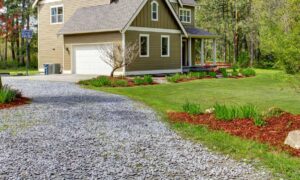In the realm of home improvement and landscaping, fencing plays a crucial role in providing privacy, security, and aesthetic appeal. Among the various fencing options available, composite fencing has emerged as a popular choice for homeowners seeking durability, sustainability, and low maintenance. This article delves into the advantages of composite fencing, its comparison with other materials, the installation process, cost considerations, and maintenance tips, offering a comprehensive guide for those considering this modern fencing solution.
Introduction
Fencing is an integral component of any residential property, serving not only as a boundary marker but also as a vital element of the overall landscape design. With the growing emphasis on sustainability and eco-friendliness, composite fencing has gained traction among environmentally conscious homeowners. Combining the best features of wood and plastic, composite fencing offers a durable, long-lasting alternative to traditional fencing materials. This article explores the myriad benefits of composite fencing, shedding light on why it has become a favored choice for many.
Overview of Composite Fencing
Composite fencing is made from a blend of wood fibers and recycled plastic, resulting in a material that mimics the appearance of wood while providing enhanced durability and resistance to the elements. The composition typically includes a mix of recycled wood fibers, reclaimed plastic, and binding agents, creating a robust material that withstands the test of time. This innovative blend not only reduces the reliance on virgin wood but also repurposes plastic waste, making it a sustainable choice for modern homeowners.
Benefits of Composite Fencing
- Durability Composite fencing is renowned for its durability. Unlike traditional wood fencing, it does not warp, crack, or splinter over time. The material is designed to withstand harsh weather conditions, including extreme heat, cold, and humidity, making it an ideal choice for various climates. Additionally, composite fencing is resistant to insect damage and rot, common issues associated with wood fencing.
- Sustainability One of the primary advantages of composite fencing is its eco-friendliness. By utilizing recycled materials, composite fencing reduces the demand for new wood and helps mitigate plastic waste. This sustainable approach aligns with the growing trend towards environmentally responsible home improvement practices. Homeowners can enjoy the aesthetic and functional benefits of wood without contributing to deforestation or increased plastic pollution.
- Low Maintenance Unlike wood fencing, which requires regular staining, painting, and sealing, composite fencing is virtually maintenance-free. The material retains its color and appearance over time, eliminating the need for frequent upkeep. A simple wash with soap and water is typically sufficient to keep the fence looking new. This low-maintenance feature makes composite fencing a convenient option for busy homeowners.
- Aesthetic Appeal Composite fencing offers a wide range of design options, allowing homeowners to choose from various colors, textures, and styles. Whether you prefer the classic look of wood grain or a sleek, modern finish, composite fencing can be customized to complement your property’s aesthetic. The versatility of composite materials ensures that you can achieve the desired look without compromising on durability or sustainability.
- Cost-Effectiveness While the initial cost of composite fencing may be higher than that of traditional wood or vinyl fencing, the long-term savings are significant. The durability and low maintenance requirements of composite fencing reduce the need for repairs and replacements, resulting in cost savings over the fence’s lifespan. Additionally, the energy savings associated with using recycled materials contribute to the overall cost-effectiveness of composite fencing.
Comparison with Other Fencing Materials
- Wood Fencing Wood fencing has long been a popular choice due to its natural appearance and versatility. However, it requires regular maintenance to prevent rot, insect damage, and weathering. Composite fencing offers a similar aesthetic without the need for ongoing upkeep. Additionally, composite fencing is more durable and resistant to the elements, making it a more practical choice for long-term use.
- Vinyl Fencing Vinyl fencing is another low-maintenance option that offers durability and resistance to weathering. However, it lacks the natural look and texture of wood. Composite fencing bridges the gap by providing the best of both worlds: the appearance of wood and the durability of vinyl. Furthermore, composite fencing is made from recycled materials, making it a more sustainable option compared to vinyl.
- Metal Fencing Metal fencing, such as aluminum or steel, is known for its strength and security. However, it can be prone to rust and corrosion over time. Composite fencing, on the other hand, is resistant to moisture and does not rust or corrode. While metal fencing may offer superior security, composite fencing provides a balance of aesthetics, durability, and sustainability.
Installation Process and Cost Considerations
Fence installation Miami, FL is relatively straightforward and can be completed by homeowners with basic DIY skills or by a professional Miami fencing company. The process involves the following steps:
- Planning and Measurement Begin by measuring the perimeter of the area where the fence will be installed. This will help determine the amount of materials needed. It’s essential to plan the layout, including the location of gates and posts.
- Preparing the Site Clear the installation area of any debris, rocks, or vegetation. Ensure the ground is level and stable. If necessary, grade the site to create a level surface for the fence.
- Installing Fence Posts Dig holes for the fence posts, ensuring they are deep enough to provide stability. The depth will depend on the height of the fence and the local building codes. Place the posts in the holes, and fill them with concrete to secure them in place. Allow the concrete to cure before proceeding.
- Attaching Fence Panels Once the posts are securely in place, attach the composite fence panels to the posts using brackets or screws. Ensure the panels are level and evenly spaced. Follow the manufacturer’s instructions for specific installation guidelines.
- Finishing Touches Add any finishing touches, such as post caps or decorative elements, to enhance the fence’s appearance. Inspect the installation to ensure all components are securely fastened and aligned correctly.
Cost Considerations
The cost of composite fencing varies based on factors such as the type and quality of materials, the size of the installation area, and labor costs. While composite fencing may have a higher upfront cost compared to wood or vinyl, its durability and low maintenance requirements make it a cost-effective choice in the long run. Homeowners should consider the total cost of ownership, including maintenance and replacement expenses, when evaluating fencing options.
Maintenance Tips
Although composite fencing is low maintenance, a few simple practices can help ensure its longevity and appearance:
- Regular Cleaning Clean the fence periodically with soap and water to remove dirt, debris, and stains. Use a soft brush or cloth to scrub the surface gently. Avoid using harsh chemicals or abrasive cleaners that could damage the material.
- Inspect for Damage Regularly inspect the fence for any signs of damage, such as cracks or loose panels. Address any issues promptly to prevent further deterioration. Composite fencing is resistant to many common issues, but occasional maintenance checks are beneficial.
- Avoid Impact Damage While composite fencing is durable, it can still be damaged by heavy impacts. Avoid placing heavy objects against the fence or using it as a support for climbing. Ensure that lawn equipment and other tools are used carefully around the fence.
- Protect from Heat Sources Composite fencing can be sensitive to extreme heat. Keep barbecue grills, fire pits, and other heat sources away from the fence to prevent warping or discoloration.
- Winter Care In regions with cold winters, composite fencing requires minimal winter care. However, it is advisable to remove snow buildup from the fence to prevent excess weight and potential damage. Avoid using metal shovels or tools that could scratch the surface.
Conclusion
Composite fencing offers a compelling combination of durability, sustainability, and low maintenance, making it an ideal choice for modern homeowners. Its ability to withstand harsh weather conditions, resist insect damage, and maintain its appearance over time sets it apart from traditional fencing materials. While the initial investment may be higher, the long-term benefits and cost savings make composite fencing a worthwhile investment for any property.
As homeowners increasingly prioritize eco-friendly and sustainable home improvement solutions, composite fencing stands out as a responsible and practical choice. By blending the best features of wood and plastic, composite fencing provides the aesthetic appeal of wood without the drawbacks of maintenance and environmental impact. Whether you are looking to enhance your property’s privacy, security, or curb appeal, composite fencing offers a versatile and reliable solution that meets the demands of modern living.
Read More From Techbullion And Businesnewswire.com



































